B0041VYHGW EBOK (101 page)
Authors: David Bordwell,Kristin Thompson

The extra factor here is a third tactic for ensuring spatial continuity—the
match on action
, a very powerful device. Assume that a person starts to stand up in shot 1. We can wait until the character is standing up and has stopped moving before cutting to shot 2. But we can instead show the person’s movement
beginning
in shot 1, and then we can cut to shot 2, which shows the continuation of the movement. We would then have a match on action, the editing device that carries a movement across the break between two shots.
To appreciate the skill involved in making a match on action, recall that most films are shot with a single camera. In filming shots whose action will be matched at the editing stage, it is possible that the first shot, in which the movement starts, will be filmed hours or days apart from the second, in which the movement is continued. Thus matching action is not simply a matter of cutting together two complete versions of the same scene from different vantage points. The director and the crew must keep notes about matters of camera work, mise-en-scene, and editing so that all the details can be fitted together in the assembly phase of production.
In the
Maltese Falcon
scene, the cut from the end of shot 5 (
6.58
) to the beginning of shot 6 (
6.59
) uses a match on action, the action being Brigid’s walk toward Spade’s desk. Again, the 180° system aids in concealing the match, since it keeps screen direction constant: Brigid moves from left to right in both shots. As you’d expect, the match on action is a tool of narrative continuity. It takes a practiced eye to spot a smooth match on action; so powerful is our desire to follow the action flowing across the cut that we ignore the cut itself.
Except for the match on action, the editing in the rest of the scene uses the same tactics we have already seen. When Brigid sits down, a new axis of action has been established (shot 6b,
6.60
). This enables Huston to break down the space into closer shots (shots 7–13,
6.61
–
6.67
). All of these shots use the shot/reverse-shot tactic: the camera frames, at an oblique angle, one end point of the 180° line, then frames the other. (Note the shoulders in the foreground of shots 7, 8, and 10—
6.61
,
6.62
, and
6.64
.) Here again, the editing of space presents the dialogue action simply and unambiguously.
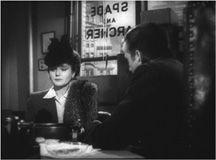
6.61
The Maltese Falcon:
shot 7.
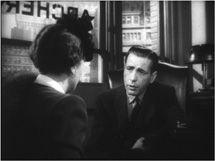
6.62
The Maltese Falcon:
shot 8.
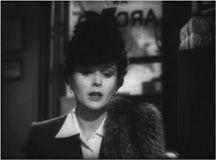
6.63
The Maltese Falcon:
shot 9.
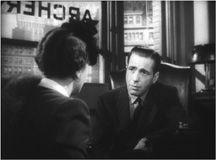
6.64
The Maltese Falcon:
shot 10.
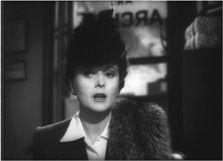
6.65
The Maltese Falcon:
shot 11.
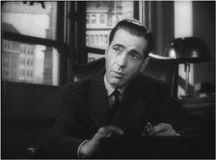
6.66
The Maltese Falcon:
shot 12.
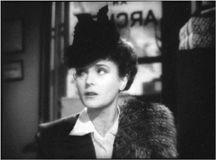
6.67
The Maltese Falcon:
shot 13.
Beginning with shot 12, Huston’s cuts also create eyeline matches. Spade looks off left at Brigid (shot 12,
6.66
). She looks off left as the door is heard opening (shot 13,
6.67
). Archer, just coming in, looks off right at them (shot 14,
6.68
), and they both look off at him (shot 15,
6.69
). The 180° rule permits us always to know who is looking at whom.
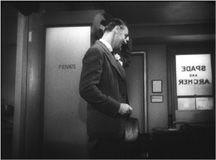
6.68
The Maltese Falcon:
shot 14.
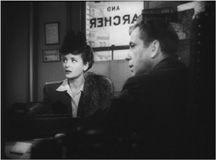
6.69
The Maltese Falcon:
shot 15.
Huston could have played the entire conversation in one long take, remaining with shot 6b (
6.60
). Why has he broken the conversation into seven shots? Most evidently, the analytical cutting controls our attention. We’ll look at Brigid or Spade at exactly the moment Huston wants us to. In the long take and the more distant framing, Huston would have to channel our attention in other ways, perhaps through staging or sound.
Furthermore, the shot/reverse-shot pattern emphasizes the development of Brigid’s story and Spade’s reaction to it. As she gets into details, the cutting moves from over-the-shoulder shots (
6.61
,
6.62
) to framings that isolate Brigid (
6.63
and
6.65
) and eventually one that isolates Spade (
6.66
). These shots come at the point when Brigid, in an artificially shy manner, tells her story, and the medium close-ups arouse our curiosity about whether she’s telling the truth. The shot of Spade’s reaction (
6.66
) suggests that he’s skeptical. In short, the analytical editing cooperates with framing and figure behavior to focus our attention on Brigid’s tale, to let us study her demeanor, and to get a hint as to Spade’s response.
When Archer enters, the breakdown of the space stops for a moment, and Huston reestablishes the locale. Archer is integrated into the action by means of a rightward pan shot (shots 16a and 16b,
6.70
and
6.71
). His path is consistent with the scene’s first axis of action, that running between Spade and the doorway. Moreover, the framing on him is similar to that used for Brigid’s entrance earlier. (Compare shot 16b with 6a [
6.71
and
6.59
].) Such repetitions allow the viewer to concentrate on the new information, not the manner in which it is presented.
